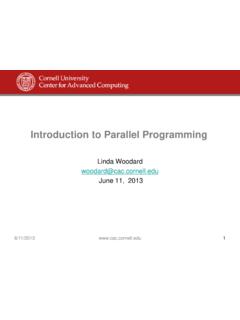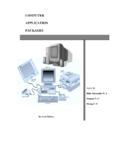Transcription of Introduction to Parallel Programming - Cornell University
1 Introduction to Parallel Programming Linda Woodard June 11, 2013 6/11/2013 1 What is Parallel Programming ? Theoretically a very simple concept Use more than one processor to complete a task Operationally much more difficult to achieve Tasks must be independent Order of execution can t matter How to define the tasks Each processor works on their section of the problem (functional parallelism) Each processor works on their section of the data (data parallelism) How and when can the processors exchange information 6/11/2013 2 Why Do Parallel Programming ? Limits of single CPU computing performance available memory Parallel computing allows one to: solve problems that don t fit on a single CPU solve problems that can t be solved in a reasonable time We can larger problems faster more cases 6/11/2013 3 Terminology node: a discrete unit of a computer system that typically runs its own instance of the operating system Stampede has 6400 nodes processor: chip that shares a common memory and local disk Stampede has two Sandy Bridge processors per node core: a processing unit on a computer chip able to support a thread of execution Stampede has 8 cores per processor or 16 cores per node coprocessor: a lightweight processor Stampede has a one Phi coprocessor per node with 61 cores per coprocessor cluster.
2 A collection of nodes that function as a single resource 6/11/2013 4 5 Definition: each process performs a different "function" or executes different code sections that are independent. Examples: 2 brothers do yard work (1 edges & 1 mows) 8 farmers build a barn A B C D E Functional Parallelism Commonly programmed with message-passing libraries 6 Data Parallelism Definition: each process does the same work on unique and independent pieces of data Examples: 2 brothers mow the lawn 8 farmers paint a barn C B A B B Usually more scalable than functional parallelism Can be programmed at a high level with OpenMP, or at a lower level using a message-passing library like MPI or with hybrid Programming . 7 Task Parallelism a special case of Data Parallelism Definition: each process performs the same functions but do not communicate with each other, only with a Master Process.
3 These are often called Embarrassingly Parallel codes. Examples: Independent Monte Carlo Simulations ATM Transactions Stampede has a special wrapper for Submitting this type of job; see in $TACC_LAUNCHER_DIR A B C D 8 Pipeline Parallelism Definition: each Stage works on a part of a solution. The output of one stage is the input of the next. (Note: This works best when each stage takes the same amount of time to complete) Example: computing partial sums A B C T0 T1 T2 T3 T4 T5 T6 T7 T8 T9 i i i i i+1 i+2 i+3 i+4 i+5 i+6 i+1 i+2 i+1 i+3 i+2 i+1 i+4 i+3 i+2 i+5 i+4 i+3 i+6 i+5 i+4 i+6 i+5 i+6 Is it worth it to go Parallel ? Writing effective Parallel applications is difficult!! Load balance is important Communication can limit Parallel efficiency Serial time can dominate Is it worth your time to rewrite your application?
4 Do the CPU requirements justify parallelization? Is your problem really `large ? Is there a library that does what you need ( Parallel FFT, linear system solving) Will the code be used more than once? 6/11/2013 9 Theoretical Upper Limits to Performance All Parallel programs contain: Parallel sections (we hope!) serial sections (unfortunately) Serial sections limit the Parallel effectiveness serial portion Parallel portion 1 task 2 tasks 4 tasks Amdahl s Law states this formally 6/11/2013 10 Amdahl s Law Amdahl s Law places a limit on the speedup gained by using multiple processors. Effect of multiple processors on run time tn = (fp / N + fs )t1 where fs = serial fraction of the code fp = Parallel fraction of the code N = number of processors t1 = time to run on one processor Speed up formula: S = 1 / (fs + fp / N) if fs = 0 & fp = 1, then S = N If N infinity: S = 1/fs; if 10% of the code is sequential, you will never speed up by more than 10, no matter the number of processors.
5 6/11/2013 11 Practical Limits: Amdahl s Law vs. Reality Amdahl s Law shows a theoretical upper limit for speedup In reality, the situation is even worse than predicted by Amdahl s Law due to: Load balancing (waiting) Scheduling (shared processors or memory) Communications I/O 6/11/2013 12 0 10 20 30 40 50 60 70 80 0 50 100 150 200 250 Number of processors Amdahl's Law Reality fp = Speedup 13 High Performance Computing Architectures 14 HPC Systems Continue to Evolve Over Centralized Big-Iron Decentralized collections Mainframes Mini Computers PCs RISC Workstations RISC MPPS Specialized Parallel Computers Clusters Grids + Clusters 1970 1980 1990 2000 NOWS 2010 Hybrid Clusters 15 Cluster Computing Environment .. Login Node(s) Access Control Compute Nodes File Server(s) Login Nodes File servers & Scratch Space Compute Nodes Batch Schedulers Types of Parallel Computers (Memory Model) Nearly all Parallel machines these days are multiple instruction, multiple data (MIMD) A useful way to classify modern Parallel computers is by their memory model shared memory distributed memory hybrid 6/11/2013 16 Shared and Distributed Memory Models 6/11/2013 17 Shared memory: single address space.
6 All processors have access to a pool of shared memory; easy to build and program, good price-performance for small numbers of processors; predictable performance due to UMA .(example: SGI Altix) Methods of memory access : - Bus - Crossbar Distributed memory: each processor has its own local memory. Must do message passing to exchange data between processors. cc-NUMA enables larger number of processors and shared memory address space than SMPs; still easy to program, but harder and more expensive to build. (example: Clusters) Methods of memory access : - various topological interconnects Network P M P P P P P M M M M M Memory Bus P P P P P P Programming Parallel Computers 6/11/2013 18 Programming single-processor systems is (relatively) easy because they have a single thread of execution and a single address space. Programming shared memory systems can benefit from the single address space Programming distributed memory systems is more difficult due to multiple address spaces and the need to access remote data Programming hybrid memory systems is even more difficult, but gives the programmer much greater flexibility Single Program, Multiple Data (SPMD) SPMD: dominant Programming model for shared and distributed memory machines.
7 One source code is written Code can have conditional execution based on which processor is executing the copy All copies of code are started simultaneously and communicate and sync with each other periodically 6/11/2013 19 SPMD Programming Model 6/11/2013 20 Processor 0 Processor 1 Processor 2 Processor 3 Shared Memory Programming : OpenMP Shared memory systems (SMPs and cc-NUMAs) have a single address space: applications can be developed in which loop iterations (with no dependencies) are executed by different processors shared memory codes are mostly data Parallel , SIMD kinds of codes OpenMP is the new standard for shared memory Programming (compiler directives) Vendors offer native compiler directives 6/11/2013 21 Distributed Memory Programming : MPI Distributed memory systems have separate address spaces for each processor Local memory accessed faster than remote memory Data must be manually decomposed MPI is the standard for distributed memory Programming (library of subprogram calls) 6/11/2013 22 Hybrid Memory Programming : Systems with multiple shared memory nodes Memory is shared at the node level, distributed above that: Applications can be written using OpenMP Applications can be written using MPI Application can be written using both OpenMP and MPI 6/11/2013 23 24 Questions?
8







